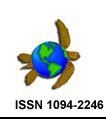 |
 |
Contemporary Herpetology – CALL FOR PAPERS
We are pleased to announce that Contemporary Herpetology, the only exclusively online, peer-reviewed journal of herpetological research is now publishing in a new format. Papers will be formatted as typeset PDF files with pagination. Previously only HTML format was used, which did not include pagination. Now that PDF formats can accommodate videos, sound files and similar multimedia, we have chosen to adopt this as the native format for CH. We anticipate that this change will generate new interest in publishing in CH.
Previously published papers will always be available in the HTML format in which they were first published, but will gradually be converted to the new PDF format as well.
Because CH has no print version, our costs of production are trivial. Thus we impose no limits upon length, and we encourage the use of color photography, color graphics or other similar enhancements. Nevertheless, papers should be written in an efficient style and are still edited for content and unnecessary length.
In addition to original empirical or theoretical findings, we are inaugurating new paper formats with Volume 2006 that we have identified as valuable to the field of Herpetology, but whose format is generally not appropriate to other established journals in the field.
• Research Perspectives are intended to highlight the findings of one or several related original papers published in non-herpetological journals. These contributions are meant not simply to summarize papers but to convey to a general audience the larger scale implications of these research findings. Research Perspectives should be short (~ 5 printed pages) and should include contextual references and may include informative display features (such as tables, figures, photographs).
• Review Papers are intended to provide a comprehensive, critical review of any major topic pertaining to any aspect of the biology of Amphibians or non-avian, non-mammalian amniotes. The burgeoning literature makes the need for outlets for review papers greater than ever, yet this demand is no longer met by standard review journals. Moreover, there is no specific outlet for such papers in the major herpetological journals. Review papers can be far-reaching and broad, but must have an emphasis on the biology of the target groups described above.
In addition to these new
paper formats, we also want to encourage the use of the Contemporary
Herpetology Information Series (CHIS) as a venue for publishing any
informative content including:
• bibliographies for certain taxonomic groups (e.g., on a species,
genus or family) or on certain topics as they pertain to the target
organismal groups (e.g., egg size variation in turtles; ESD in squamates).
• Large data sets, whether original empirical data, or compilations
of published data, that cannot otherwise be archived with a relevant
published paper to which they relate;
• Historical pieces on herpetological figures or issues that have
clear value as documentary of taxonomic decisions or other issues;
• Historically important documents, photographs, translations,
type descriptions and other similar materials that are not generally
available in their native format or other reprinted forms. Publication
of such materials will be contingent on documenting appropriate rights
to publish, and that no copyright restriction applies.
• Identification guides that rely upon technical details and provide
technically valid illustrations.
• CH will not publish travelogues but may consider publication
of first hand accounts of expeditionary research into poorly studied
areas, especially if they contain informative content of herpetofauna
and herpetofauanal habitats.
Once published CHIS articles may be updated via supplements (or new editions when they are substantially changed in the view of the editor) although prior versions will always be available as originally published.
Review Process and Publication.
All contributions to CH
are peer-reviewed by members of the editorial board and generally by
ad hoc reviewers. The entire process is conducted via the internet.
For typical papers, generally accepted criteria are used such as - data
have not appeared elsewhere, the study design, methods, analyses and
so on are technically sound, and the paper is written clearly. Decisions
to publish non-traditional format papers (e.g., bibliographies, historical
pieces) will relate completeness and import of content (e.g., a historical
essay, though well written, could be rejected if the reviewers and reviewing
editors judge that it does not make any important new contribution to
our understanding of that issue). An important goal of CH is to publish
without undue delay, but not at the cost of maintaining a high quality
product. Because the types of papers and the levels of technical detail
among them vary a great deal, time in review may vary considerably depending
on the availability and efficiency of appropriate reviewers. Also CH
is entirely voluntary and has no support staff, so the pace of review
and publication also reflects the variable workloads of these volunteers.
Given these constraints, CH publishes accepted papers as soon as possible
after finalized proofs are received.